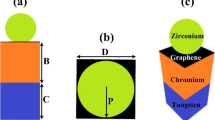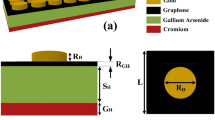Abstract
Energy harvesting is renowned in the past flue decades, and renewable energy is the superlative cause of the energy. Researchers investigated many surface plasmon resonance structures for the same, but the materials they have used prevent more losses. In this work, graphite, Al2O3, ZrO2, and TiO2 are used in order to gather greater amounts of sunlight. The Sharp Triangular Structure — Ring (STSR) Shape has been created using various lithography techniques to increase absorptance and obtain 95.35% of the solar spectrum (0.2–2.5-µm wavelength) to get the greatest results with these materials. The structure’s absorption rates for the UV, VIS, and IR regions are 97.49, 96.28, and 94.99%, respectively. The role of the resonator is also explained in this study with magnetic and electric field norms. The graphite substrate has an absorptance of 67.63%, a reflectance of 32.20%, and a transmittance of 1.39%. Applying the resonator causes a reduction in reflectance of up to 27.82% and results in 95.35% absorptance. It could function as a radiation barrier, solar induction heater for water and air, and many other things. It is applicable in space missions and satellite since it can capture the majority of the radiation from space.









Similar content being viewed by others
Availability of Data and Materials
The data supporting the findings in this work are available from the corresponding author with reasonable request.
References
Wilkerson JT et al (2010) Analysis of emission data from global commercial aviation: 2004 and 2006. Atmos Chem Phys 10(13):6391–6408. https://doi.org/10.5194/acp-10-6391-2010
Sayed ET et al (2023) Renewable energy and energy storage systems. Energies 16(3). https://doi.org/10.3390/en16031415
Wang Y, Chen K, Lin YS, Yang BR (2022) Plasmonic metasurface with quadrilateral truncated cones for visible perfect absorber. Phys E Low-Dimens Syst Nanostruct 139. https://doi.org/10.1016/j.physe.2022.115140
Elsayied Ali KT, Suleiman Khayal DOME, Bashier Elagab DE (2022) Analysis of a flat plate solar collector. Int J Eng Appl Sci Technol 7(6):117–121. https://doi.org/10.33564/ijeast.2022.v07i06.006
ASHRAE (2020) ASHRAE handbook-HVAC systems and equipment
Gielen D, Boshell F, Saygin D, Bazilian MD, Wagner N, Gorini R (2019) The role of renewable energy in the global energy transformation. Energy Strateg Rev 24:38–50. https://doi.org/10.1016/j.esr.2019.01.006
Zhang H, Cao Y, Feng Y, Yi Z, Liu H, Wu X (2023) Efficient solar energy absorber based on titanium nitride metamaterial. Plasmonics. https://doi.org/10.1007/s11468-023-01932-8
Chen R et al (2023) Plasmon-enhanced infrared absorption in graphene nanodot array. Plasmonics. https://doi.org/10.1007/s11468-023-01939-1
Djurišić AB, Li EH (1999) Optical properties of graphite. J Appl Phys 85(10):7404–7410. https://doi.org/10.1063/1.369370
Chung DDL (1983), Physics of graphite by B. T. Kelly, Acta Crystallogr. Sect. A Found. Crystallogr. 39(1):192–192. https://doi.org/10.1107/s0108767383000422
Wu P, Dai S, Zeng X, Su N, Cui L, Yang H (2023) Design of ultra-high absorptivity solar absorber based on Ti and TiN multilayer ring structure. Int J Therm Sci 183. https://doi.org/10.1016/j.ijthermalsci.2022.107890
Zheng Y et al (2023) Numerical simulation of efficient solar absorbers and thermal emitters based on multilayer nanodisk arrays. Appl Therm Eng 230:120841. https://doi.org/10.1016/j.applthermaleng.2023.120841
Patel SK, Agravat D, Alsalman O, Surve J, Taya SA, Parmar J (2023) Numerical analysis of wideband solar absorber using thick film with glassy material, resonator and back reflector. Opt Quantum Electron 55(9):754. https://doi.org/10.1007/s11082-023-04982-8
H. Gao et al (2018) Refractory ultra-broadband perfect absorber from visible to near-infrared. Nanomaterials 8(12). https://doi.org/10.3390/NANO8121038
Parmar J, Patel SK, Katrodiya D, Nguyen TK, Skibina JS, Dhasarathan V (2020) Numerical investigation of gold metasurface based broadband near-infrared and near-visible solar absorber. Phys B Condens Matter. https://doi.org/10.1016/j.physb.2020.412248
COMSOL Multiphysics® v. 6.0.
COMSOL (2014) Introduction to COMSOL Multiphysics 5.3, Manual 168.
Hu B, Yao M, **ao R, Chen J, Yao X (2014) Optical properties of amorphous Al2O3 thin films prepared by a sol-gel process. Ceram Int vol. 40, no. 9 PART A, 14133–14139. https://doi.org/10.1016/j.ceramint.2014.05.148
Evtushenko YM, Romashkin SV, Trofimov NS, Chekhlova TK (2015) Optical properties of TiO2 thin films, in Physics Procedia. 73:100–107. https://doi.org/10.1016/j.phpro.2015.09.128.
Lee S, Shin HJ, Yoon SM, Yi DK, Choi JY, Paik U (2008) Refractive index engineering of transparent ZrO2-polydimethylsiloxane nanocomposites. J Mater Chem 18(15):1751–1755. https://doi.org/10.1039/b715338d
Jonsson AK, Niklasson GA, Veszelei M (2002) Electrical properties of ZrO2 thin films. Thin Solid Films 402(1–2):242–247. https://doi.org/10.1016/S0040-6090(01)01715-1
Patel KJ, Desai MS, Panchal CJ (2012) The influence of substrate temperature on the structure, morphology, and optical properties of ZrO2 thin films prepared by e-beam evaporation. Adv Mater Lett 3(5):410–414. https://doi.org/10.5185/amlett.2012.5364
Agarwal S, Prajapati YK (2019) Multifunctional metamaterial surface for absorbing and sensing applications. Opt Commun 439:304–307. https://doi.org/10.1016/j.optcom.2019.01.020
Ma P et al (2017) Fast fabrication of TiO2 hard stamps for nanoimprint lithography. Mater Res Bull 90:253–259. https://doi.org/10.1016/j.materresbull.2017.03.010
Virbukas D, Laukaitis G, Dudonis J, Katkauske O, Milčius D (2011) Scandium stabilized zirconium thin films formation by e-beam technique. Solid State Ionics 184(1):10–13. https://doi.org/10.1016/j.ssi.2010.09.023
Madani A, Nakhaei M, Karami P, Rajabzadeh G, Salehi S, Bagheri H (2016) Sol-gel dip coating of yttria-stabilized tetragonal zirconia dental ceramic by aluminosilicate nanocomposite as a novel technique to improve the bonding of veneering porcelain. Int J Nanomed 11:3215–3223. https://doi.org/10.2147/IJN.S104885
Tang X, Yan X (2017) Dip-coating for fibrous materials: mechanism, methods and applications. J Sol-Gel Sci Technol 81(2):378–404. https://doi.org/10.1007/s10971-016-4197-7
Singh RS, Bhushan S, Singh AK, Deo SR (2011) Characterization and optical properties of Cdse nano-crystalline thin films. Dig J Nanomater Biostruct 6(2):403–412
Air Mass 1.5 Spectrum, American society for testing and materials (ASTM).
Yu P et al (2020) Ultra-wideband solar absorber based on refractory titanium metal. Renew Energy 158:227–235. https://doi.org/10.1016/j.renene.2020.05.142
Patel SK, Surve J, Prajapati P, Taya SA (2022) Design of an ultra-wideband solar energy absorber with wide-angle and polarization independent characteristics. Opt Mater (Amst)131:112683. https://doi.org/10.1016/j.optmat.2022.112683
Z. Liu et al (2019) Truncated titanium/semiconductor cones for wide-band solar absorbers. Nanotechnology 30(30). https://doi.org/10.1088/1361-6528/ab109d
Obaidullah M, Esat V, Sabah C (2021) Multi-band (9,4) chiral single-walled carbon nanotube based metamaterial absorber for solar cells. Opt Laser Technol. https://doi.org/10.1016/j.optlastec.2020.106623
Patel SK, Charola S, Jadeja R, Nguyen TK , Dhasarathan V (2021) Wideband graphene-based near-infrared solar absorber using C-shaped rectangular sawtooth metasurface. Phys E Low-Dimens Syst Nanostruct 126: 114493 https://doi.org/10.1016/j.physe.2020.114493
Yu P et al (2019) A numerical research of wideband solar absorber based on refractory metal from visible to near infrared. Opt Mater (Amst). https://doi.org/10.1016/j.optmat.2019.109400
Funding
This work was funded by the Deanship of Scientific Research at Najran University under the Research Groups Funding program grant code (NU/RG/SERC/12/1).
Author information
Authors and Affiliations
Contributions
Conceptualization, Shobhit K. Patel; methodology, Abdulkarem H. M. Almawgani; software, Dhruvik Agravat and Shobhit K. Patel.; validation, Abdulkarem H. M. Almawgani, Muhammad Irfan, Ammar Armghan, and Sofyan A. Taya; writing—original draft preparation, Dhruvik Agravat; writing—review and editing, all the authors. All the authors have read and agreed to the published version of the manuscript.
Corresponding author
Ethics declarations
Ethical Approval
Not applicable.
Conflict of Interests
Not applicable.
Additional information
Publisher's Note
Springer Nature remains neutral with regard to jurisdictional claims in published maps and institutional affiliations.
Rights and permissions
Springer Nature or its licensor (e.g. a society or other partner) holds exclusive rights to this article under a publishing agreement with the author(s) or other rightsholder(s); author self-archiving of the accepted manuscript version of this article is solely governed by the terms of such publishing agreement and applicable law.
About this article
Cite this article
Agravat, D., Patel, S.K., Almawgani, A.H.M. et al. Graphite-Based Surface Plasmon Resonance Structure Using Al2O3-TiO2-ZrO2 Materials for Solar Thermal Absorption. Plasmonics 19, 227–238 (2024). https://doi.org/10.1007/s11468-023-01986-8
Received:
Accepted:
Published:
Issue Date:
DOI: https://doi.org/10.1007/s11468-023-01986-8




